Vol. 2 レポート 企業による芸術支援のための連合会議
マレーシアでの新しい動き
New Movements in Malaysia
vol.2 レポート 企業による芸術支援のための連合会議、マレーシア
Report : 5th Coalition for Corporate Support for the Arts
2015年より協議会で実施している「ASEAN諸国における企業メセナの促進とネットワーク構築に向けた調査・協議」(助成:国際交流基金アジアセンター)。本年は、この3年間交流を深めた各ASEAN文化団体へのインタビュー・コラムや、視察レポートを連載しています。
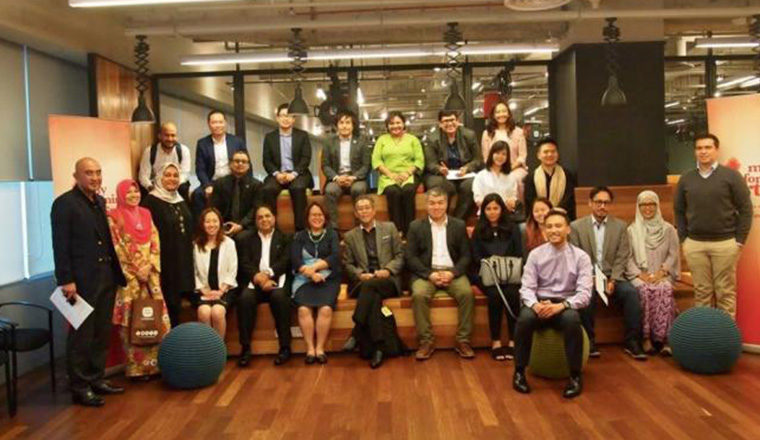
企業による芸術支援のための連合会議 5th Coalition for Corporate Support for the Arts
マレーシア企業による芸術支援連合を正式に設立させるため、「企業による芸術支援のための連合会議」が継続的に開催されています。第5回目の本会議では、マレーシアにて次に何をすべきかということについての具体的議論が交わされました。コラムでは、会議での議論をレポートで紹介します。
企業による芸術支援のための連合会議
マイ・パフォーミング・アーツ・エージェンシー(MyPAA)主宰。2014年に企業メセナ協議会主催の国際会議にMyPAAがゲストに出席したことを機会に、マレーシアでも民間企業による芸術文化支援の促進とネットワーキングを目指し、マレーシア企業による社会貢献(CSR)、ブランディング、フィランソロピーの活性と促進を担う企業のための会議として2014年から始まった会議。毎年2回開催されるこのラウンドテーブル会議では、マレーシアでより持続可能な芸術文化活動を振興そして発展させるべく企業の寄付、投資、そしてパートナーシップを活性化させていくことを目的としている。
Coalition for Corporate Support for the Arts
Hosted by My Performing Arts Agency (MyPAA), Coalition for Corporate Support of the Arts was created in 2014 for promoters of corporate social responsibility (CSR), corporate branding, and corporate philanthropy. This dialogue started from the time when MyPAA was introduced to KMK Japan and its international conference, inspiring MyPAA to bring back the concept and best practice of Japanese corporate support of the arts. The biannual roundtable aims to grow the culture of giving, investment, partnership, bringing partners together to foster a more sustainable and vibrant arts and culture sector in Malaysia.
This 5th meeting also included a discussion on the next course of action to formalize the Coalition of Corporate Support for the Arts Malaysia.
企業が連携し芸術支援を行うための場づくり Formalizing Coalition of Corporate Support for the Arts
ブライアン・ジョンソン・ロウエ(ディレクター、マイ・パフォーミング・アーツ・エージェンシー)
Brian Johnson Lowe (Co-founder/Director, My Performing Arts Agency)
マレーシアでは、企業や企業財団による芸術文化の資金提供と発展のために、参加者のみなさんが重要な役割を果たすと考えています。政府機関、クリエイティブ産業、アーティストも、私たちが何をするべきか、互いの違いを認め、各分野での役割や、どのように相互協力ができるか、対話していくことが必要です。
Everyone is here because corporations and foundations play an important role in funding arts and culture as well as the development of it in Malaysia. Much like any government agency, industries or even artists, there needs to be a dialogue amongst all of us to understand what we do and how we differ from each other, what sectors we play a role in and how we could potentially collaborate with one another.
マイパはボラック・アーツ・シリーズ (コラム①参照)を通じて芸術界の境界線を打ち破り、対話の場をつくることに成功しました。これはまた、企業同士が対話を持つ必要があることがわかった場でもあったかと思います。みなさんが様々な場面で会話をしていることはご承知の通りですが、このように関係者が集まる正式な場での客観的議論・目的認識が必要だと考えています。
MyPAA started to break boundaries in the artistic realm through Borak Arts Series (Refer to Column ①) where a platform for the dialogue was created. This was where it was seen that corporates also need to have a dialogue. It is known that a lot of conversations happened offline but there needs to be a formal objective discussion where all parties can come together and move towards a particular target.
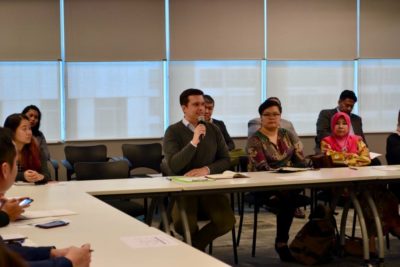
2016年8月にクアラルンプールで開催された第1回目の企業メセナ協議会主催によるクアラルンプール会議では、マイパが毎年開催しているボラック・アーツ・シリーズよりも多くの参加者が参加していました。このことから、こういった話し合いは、企業や企業財団にとってもとても興味があることで、一緒になり何かを成し遂げたいと思っていることが明白になったのです。したがって、この第5回企業芸術支援のための連合会議は、みなさんが共に芸術支援をすることができるような方向にさらに絞り込むための議論を交わす場として開催されています。
Following that, the first KMK corporate conference at Kuala Lumpur in 2016 brought more participants than Borak Arts Series which clearly shows that there is interest from the corporate sector and everyone wants to come together to do something. And therefore, this 5th Roundtable is organized to further narrow down the direction into something that everyone can work together towards.
“最初に判明したことは、すべての企業や財団が芸術と文化に多額の資金を投入しているということですが、それは本当に社会に影響を与えているかどうかということです。すべての支援活動がどのような結果を出しているのかを知るためのデータやベースラインはありませんでした。 ”
“One of the first things that was identified was that all corporations and foundations are putting in a lot of money into arts and culture but the question is whether it is really producing any impact. Some organizations measure it with precision, however at a national level, is there any impact that we can collectively claim to have achieved? We did not have any data or baseline to know if all that has been done is producing results. “
マイパの共同創設者である、イザン・サトリナが正式にマイパを退職し、6月から政府機関であるマイ・クリエイティブ・ベンチャーズの下にあるユニットである文化経済開発部門(CEDU)を率いています。マイパは、文化経済発展部門の顧問として政策レベルで国内最高の芸術擁護家であることに引き続き取り組んでいきます。
The founder of MyPAA, Izan Satrina, has left the company to lead the Cultural Economy Development Unit (CEDU), which is a unit under My Creative Ventures. With that, MyPAA will continue to work at being the best arts advocate in the country at a policy level as an advisor to CEDU.
文化経済発展部門の計画 Blueprint
イザン・サトリナ・モハメド・サレフディン(最高顧問、文化経済発展部門)
Izan Satrina Mohd Sallehuddin (CEO, Cultural Economy Development Unit/ CEDU)
まずは、この部門がどのようなものなのか、どのようにみなさんと一緒に進んでいくことができるかを、この部門が課された使命とともに簡単にお知らせしたいと思います。
I’ll take you through very quickly on what it is about and how we can possibly worktogether, once you understand what we are set up to do.
マイパは過去5年間にわたりロビー活動を続けてきました。芸術が、国家の課題として重要であると主張したのですが、去年8月に首相と会うまで、このポリシーを発展させることはできませんでした。首相との会合と、チームとの4回の会合の後、国家予算で、芸術支援・投資資金の配分が発表されました。
Our journey with MyPAA throughout the past 5 years is constant lobbying and advocating for arts to be more significant on a national agenda, we have not been able to move mountains as much until meeting the Prime Minister in August last year. Following the meeting and another four meetings with his team, it was announced at the national budget an allocation for the funding of the arts, of which I have been tasked to lead.
「政府は、創造性と革新性について特に創造的な経済力を期待しているが、それを動かすことができるのが芸術文化であるという核心を理解していない」と首相は話しました。。芸術文化には異なる定義が様々あり、また国家創造的産業政策としての定義もありますが、ここでの議論の目的で、サブセクターをいくつか見ていくことにしましょう。
Our story to the Prime Minister is that the government was talking a lot about creativity and innovation, and expects a creative economy powerhouse, but has yet to really massage the heartbeat of it all which is arts and culture. There are different definitions of arts and culture, there is a national creative industry policy definition as well, but for discussion purposes we will just look at these few subsectors.
創造経済は大規模な産業ですが、マレーシアではまだ最適化されていません。英国だけでも1時間に1,000万ポンドの収穫がありますが、マレーシアでは、すべてのサブセクターが自分たちのデータを測定しているかどうかわからないため、創造的な経済力を実際に数値化することはできません。
Creative economy is a massive industry but has yet to be optimized in Malaysia. In UK alone, it churns out 10 million Pounds an hour, but for Malaysia we are not able to really articulate the power of creative economy because unfortunately every subsector may or may not be measuring their own data.
公平にいうと、政府は5年ごとに50万リンギットを芸術に投入しています。しかしながら、芸術文化を担うサブセクターと、それを管理する機関の配分を見てみると、ある程度決まった額がいっていることが分かります。各サブセクターには1人から3人の担い手がいるかもしれませんし、そうでないかもしれないかもしれません。おそらくある程度活発に行動している、もしくは非常に活発なNGOがそのサブセクターを導く場合もあるでしょう。例えば、ファッション&テキスタイル分野の場合、実際にそのサブセクターを担っている政府機関は存在しません。私たちは、多くの担い手がいるのを見ることができますが完全にそれぞれのセクターを担っている機関はありません。また、まだ資本化されておらず、一緒に働くことができる機会が多々あります。
To be fair to the government, they have been putting in half a million (RM) into the arts every five years. However, when you see the breakdown of the subsectors of the arts and culture and the different custodians, a certain segment of that allocation goes to each and every one of them. In each subsector, there may be one to three custodians or there might even not be any so in that space perhaps an intermediary or very active NGO will be leading that subsectors. For instance, fashion & textiles, there isn’t really a government body heading that subsector. We can see there are a lot of cooks in this whole space (ecosystem) but nobody is really pulling it altogether. There is a list of opportunities that has yet to be capitalized and could be worked on together.
税制優遇措置について tax exemption
政府に提案されたことの一つは税制優遇です。1リンギットを芸術に寄付すると2リンギットを返却するという法人税の免除がありました。しかしながら、政府はまだその制度を公表することに熱心ではありませんでしたが、文化経済発展部門について議論する意思がありました。 文化経済発展部門は、舞台芸術、ビジュアルアーツ、ライブ音楽などの中小規模のスペース(未定義だが、500席または300席以下のスペース)および公共スペースというサブセクターに焦点を当てています。私たちが本当にやろうとしていることは、独立した地方での活動、草の根活動、フリンジコミュニティにもっと多くの機会を提供することです。私たちは地元の人材を育成して、より広い経済に付加価値を持たせたいと考えています。
There are two things which were proposed to the government; one was the corporate tax exemption which for every RM1 you put into the arts, you get RM2 back in return, which the government was not keen on releasing that revenue yet but they were willing to discuss the Cultural Economy Development Unit (CEDU). CEDU essentially focuses on selected subsectors in performing arts, visual arts, live music, small and medium spaces (yet to be defined; less that 500pax or 300 pax) and public spaces. What we are really trying to do is to provide more opportunities for the independent local scene, grassroots and fringe communities. We are also building local talent and want to value add to the wider economy.
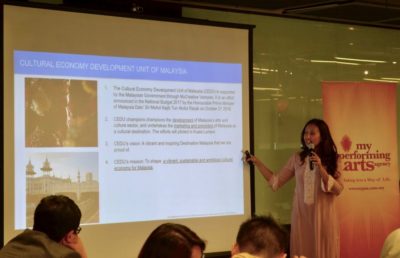
文化経済発展部門は、活性力、能力向上(芸術の権力)、再編成の3つのキーワードをもとに経済を創造したいと考えています。
CEDU hope to create that economy with the 3 values which are Energizing, Empowering and Reorganizing.
どのようにマレーシアの経済を芸術文化で活気づけるか?需要を刺激し、文化芸術の見える化することによってです。プロファイリングすることにより、ソフトパワーイメージを作成し、誰もが特定のターゲット市場において芸術に参加・鑑賞することができるようにします。たとえば、学校休暇中に多くの芸術や文化関連の活動を奨励するなどです。ショッピングモールに行くのではなく、博物館やミュージカルを無料で見ることができます。家族のためのマレーシア遺産めぐりといった活動を通して、コミュニティに芸術を再導入することが目的です。また見える化を促進することで、需要をさらに生み出し、またそれが芸術文化の見える化につながります。これが都市を活性化するのです。
How to energize? By stimulating demand and creating visibility. By profiling, creating soft power imaging, getting everyone or specific targets markets to participate and conceive the arts. For example: encouraging more arts and culture related activities during school holidays; instead of going to shopping malls, they can go museums or musicals for free. The goal is to reintroduce the arts to our communities via activities like heritage trails for families, maybe tie in with promotional products to create more opportunities for cross marketing. By creating demand, the demand will respond to the supply; this will create the vibrancy for the city.
最も重要なのは、これらのすべてが国の政策であることです。なぜなら、今ある芸術文化政策は適切ではない可能性があるからです。例えば現在、政府は許可証とライセンス証書を発行していますが、国際的な芸術による協働活動をしたい場合最大30,000リンギットの預金を支払わなければなりません。アーティストはこれを支払う余裕がありません。これらの政策は、芸術の成長を促すものではありません。
Most importantly, all of these are policies, because policies for the arts may not be as relevant at the moment. For example; DBKL currently has a permit and license deposit, if you want to do an international collaboration you have to pay the deposit amounting up to RM30,000. Artists can’t afford to pay this. These policies aren’t encouraging for the growth of the arts.
現在、芸術に資金を提供する法人資金提供者のための税制政策がありますが、それはすばらしい反面、その手続きが非常に複雑で、資金提供者にも芸術家たちにも助けとなっていないのが現状です。おそらく、このような課題は、企業のパートナー集団を通じて、声をあげ改善することができるのではないかと考えています。もう一つの可能性は、この連合会議が協会・組織として設立されれば、文化経済発展部門と連携し、マレーシアの芸術生態系(エコシステム)の一部を共同で資金提供できるのではないかと考えています。
Another example, currently there is a tax policy for corporate funders who fund the arts to receive tax exemption returns, which is great but the processes to access that policy is very complicated which is not encouraging for the funder nor the artists. Perhaps challenges like this can be addressed through a collective of corporate partners to be the voice and potentially achieve a lot more. Another possibility is, if this collective is set up as an association, CEDU and this said association can co-fund certain parts of the Malaysian arts ecosystem.
例えば、INXO芸術文化基金(芸術文化教育を持続的に管理・発展させるために設立された財団)にはかなりの資金がありますが、アーティスト育成という面は欠けているようです。しかし文化経済発展部門が育成事業に助成することで、アーティストの指導ができるプログラムをつくることもできるのではないでしょうか?これからのアーティストが長期的に活動を持続できるようにしていくというのが私たちの使命です。
For example, INXO Foundation ( The INXO Arts & Culture Foundation was established to manage and develop arts and culture education in a sustained manner) has a pretty big amount of funding available, but perhaps what is lacking was mentorship for the artist, which CEDU could potentially help with funding the mentorship so that the programme is more complete in terms of experience, growth, and output, to create long term sustainability of these artists.”
<ディスカッション:企業芸術支援のための連合設立に向けて>
メセナ協議会の事例に関してのコメント(日本における民間の芸術文化支援)について
Comment on the programme of Mécénat, KMK Japan
ジア・ピング(シンクシティ)Jia Ping from Think City
日本の芸術支援にとって、アートそのもの・アートという美に投資することは、資本利益率の期待値だと、前回東京視察・会議に参加して感じました 。市民・社会に芸術という美そのものを還元していると言っている企業は非常に健全なバランスが取れています。 こういったものを数字化することはできないのですが。
For Mécénat, there is a very clear demonstration of investing in just the beauty of the arts minus any ROI expectations. There is a very healthy balance of corporations saying that they are giving back the beauty to the citizens and there are some with hard measures. Therefore, not everything that counts can be counted.
連合の創設に同意・連合機関のモデルについてAgreeing to creating Coalition
サレフディン・モハメド・サレー(文化芸術国立省、MOTAC)Sallehuddin Mohd Salleh , National Department for Culture and Arts, MOTAC
日本を視野におき、企業を通じた芸術や文化の振興を速やかに進めることは、非常に良い取り組みだと思います。 日本企業の支援活動や企業メセナ協議会をモデルとして取り上げ、提携や連合を結び、芸術を速いペースで促進するための体系化した組織を持つことができるのではないでしょうか。そうすれば、アーティストにとってもとてもやりやすいと思います。なぜなら、様々な機関をうろうろせずともこの一機関に行けばいいわけですからね。これは、適切なチャネリングと構造で、これらの芸術家を導くワンストップ機関のようなものですね。
Looking towards Japan, fast moving in promoting arts and culture via corporations, I think it is a very good initiative. Why don’t we try our best to take this as a module, to have an alliance or coalition so that we can have a structured organization promoting the arts in a fast pace, which is also easier for the arts practitioners to go to one particular organization that can complement towards industry, rather than going individually, it’s like a one-stop agency to guide these art practitioners, with proper channeling and structure.
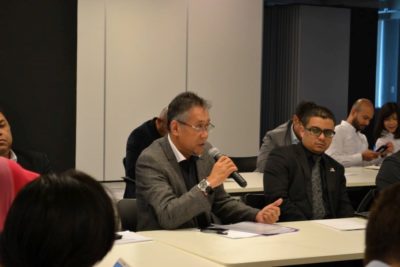
ビジネスマンのアプローチから見て Looking at it from a business person’s approach
ダツク・ヴィノード・セカー(セカー財団)Datuk Vinod Sekhar from Sekhar Foundation
マレーシアの芸術支援のための資金があることは疑いませんが、全面的に広がりすぎていて、管理不備があると思います。マレーシアが本当に必要としていることを理解しているかも分かりませんし、芸術(映画、劇場、音楽など)は何か、というそもそもの疑問もあります。必要とされるのは、私たちが最初にやるべき実践的なアプローチです。一つのことのコンセンサスを作り、そこから発展させていく。あまりにも多くの分野で広がり過ぎて目的を達成できない傾向があります。
With so many organizations here, there is no question that there is money for the arts in Malaysia, but is has spread all over the place and mismanaged. There is a breakdown in understanding what Malaysia really needs, and then there’s the questions of what is the arts (film, theatre, music, etc)? What is required is a real pragmatic approach to what we need to do first. Create a consensus of one thing and make that work really well, then build from there. There is a tendency to spread too far wide with too many areas and not making progress or achieving the success that is needed.
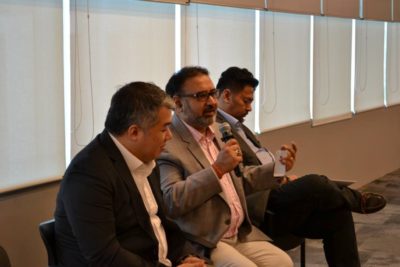
私たちセカー財団は、過去18 – 20年間、マレーシアの芸術8000万リンギットを支援してきました。なぜなら、私たちはマレーシアの芸術支援は必要であると信じているからです。私たちは劇場、芸術プログラム、映画に資金を供給し、それをもっと積極的に進める必要があると考えています。彼らが信じれば、ビジネスマンは思っているよりもずば抜けたキャパシティや能力があります。できるだけ多くのCEOやビジネス関係者を参加させてください。
What we (Sekhar Foundation) have done in the last 18 -20 years; amounts to RM80million, spent on the arts on Malaysia because we believed in it. We funded theatre, art programs, films to push things up and there needs to be an aggressive approach to that. Business people are more capable than you think once they believe in it. Get as many CEOs and business people involved, and if you do, I think you’ll be surprised at how much can be achieved.
芸術は経済的に評価される必要がある Arts needs to be appreciated economically
ヨハン・イシャーク(マイ・クリエイティブ・ベンチャーズ) Johan Ishak from My Creative Ventures
政府の予算要求に取り組んだ経験をもとに、芸術が政府の予算配分の優先順位にはないことに気付きました。マレーシアという国を見てみると、まだ若いとみなされています。過去の首相は、国家予算を国家、貧困、近代化に優先させなければならなかったのです。過去5年間、芸術にはほとんど焦点が当てられていませんでした。現在の首相は芸術に対してオープンですが、彼のチームを説得するのはまだ難しいです。イザンと共に、財務省に説明しようと試みてはいます。しかしながら、政府は審美的価値の代わりに資本利益率をより多く見ていることを示しているだけです。彼らは経済の乗数効果を見たいと思っています。彼らは投資したドル、収益生成のための乗数が何であるかを調べます。マレーシアは開発段階の終わりにあり、2020年までに発展したいと考えていますがまだ発展途上で先進国に移行する準備ができていません。イザンの需要と供給のポイントについて言及したいと思います。様々な企業のスポンサーシップは、主に芸術の生産コストとプロモーションに寄与していますが、提案したいのは、このような状況に対処するために、おそらく青少年、特に学校の子供たちに芸術を体験するように教えるためのスポンサーシップです。芸術の消費者になるように、幼少時代から芸術を評価するように教える。教育制度を通るのは時間がかかりすぎると考えています。
Through experience of working with budgets requests from the government, I’ve come to realize that we (the arts) are not there in the government’s priority for budget allocations. If you look at the country, we are still considered young. The past prime ministers had to prioritize the national budget on other things from sovereign, poverty, to modernization. The focus was pretty much not towards arts for the past five years. The current Prime Minister is more open to it but it’s still hard to convince his team. Together with Izan, trying to explain to the Ministry of Finance, only shows us that the government looks more at ROI instead of aesthetic values. They want to look at the multiplier effect for the economy. They look at every dollar that they invest, what the multiplier for revenue generation is. Malaysia is not yet developed but are at the end of the developing stage and we want to be developed by 2020 and the grey area we are in is not helping us. We (the government) are not ready to change to a developed nation yet. I would like to refer back to Izan’s point of supply and demand, the sponsorships that has been disbursed by various corporation, is mainly contributed towards the cost of production of the arts and the promotion, if I may suggest, perhaps there should be sponsorship to educate youth, especially school kids to experience the arts. Teach them to appreciate and value the arts from a young age so that they will grow to become paying consumers of the arts. Going through education system will take too long.
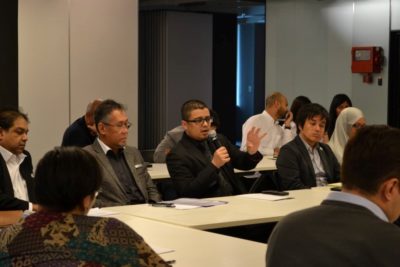
日本企業が現在行っている芸術文化支援はどれもかならず後世まで残るものだと思っています。例えば、10年以上つづいている活動は多々あります。年月という事実をみただけでも、その活動自体が日本文化の一部となるわけで、結果的に日本文化を保存しているということだと私は思います。ですから、数字化と継続性は対という考えではないように思いますが。
I believe that any artistic and cultural support that Japanese companies are currently doing will remain until future generations. For example, there are many activities that have been going on for over 10 years. I think that even the achievements of the years and months alone are preserving Japanese culture itself. So it seems that digitization and continuity are not ideas of pairing.
ハスル・ハディ・サムスディン(MDEC)Hasnul Hadi Samsudin, MDEC
コンテンツへのアクセスにより、クリエイターがより多くの視聴者にアクセスできるようになりました。たとえば、YouTuberはオンラインプラットフォームで、数分で視聴者を増やすことができます。芸術をアクセシブルにする方法を理解する必要がありますよね。芸術をより認識しやすくし、視聴者を作りましょう。欠けているのは、クリエイター/アーティストのプロモーション/マーケットアクセスです。みなさまがこの連合を設立しようとしているなら、その連合のためのプラットフォームがあることを確かめてください。
Access to content has allowed a lot of creator to access a bigger audience. For example a YouTuber can grow an audience within minutes on the online platform. We need to figure out how to make arts accessible? Make arts more recognizable, create your audience. What’s lacking is the promotion/market access for creators/artists. If you are going to create this coalition, make sure there is a platform for it.
才能開発・才能発掘 Talent development
グレイ・ヨー(ブリティッシュ・カウンシル)Grey Yeoh, British Council
私はマレーシアでは、発掘・開発が必要な多くの才能があると思います。私たちが世界に売れる(誇れることができる)マレーシア製品を考え出すために、それは国内市場か国際市場かにかかわらずです。
I think in Malaysia there is a lot of talent that needs to be developed. In order to come up with a Malaysian product that we can sell, whether it is to the internal market or even international market. An example:
例えば、シアターショーウォーホースは、今や大規模でチケット売切れ必須のショーです。ニューキャッスルに25人収容可能な劇場スペースから小さなワークショップのパフォーマンスとして始めたものです。彼らは何度もテストし、その後、地方の劇場、国レベルでの公演、海外へと渡り映画になりました。人々は企業などがすぐに強力なミュージカルや大きなステージに投資できると考えていますし、売り切れるであろうとも思いますが、実際はそうではありません。脚本や劇作家に取り組んだり、何度か試したりしなければならないのです。芸術への多額の投資は資本利益率をすぐに見ることを望みます。彼らは投資で素晴らしいショーを見たいと思いますが、それは時間がかかるため不可能です。私は資金提供者に、助成金を与えるのではなく、才能に投資することを考えるように促すでしょう。
Theatre show War Horse, now a massive sellout show, first started as a small workshop performance in a small theater space that can fit 25 people in Newcastle. They tested and tested it with the audience and developed it. Then it became a regional theatre show, and then movie. People think that you can immediately invest in strong musical and big stages and that it will sell out, but that’s not how it goes in real life, you have to work on the script, playwright and test it out several times. A lot of investment in the arts plans to see the ROI immediately, they want to see a fantastic show with their investment but that is not possible, it takes time. I would urge funders to think about investing rather than giving grants, in talent.
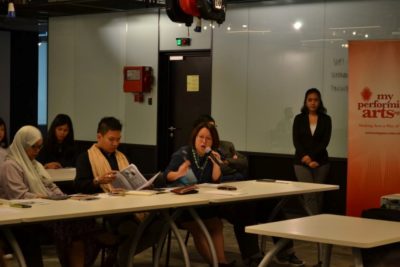
芸術を「採用する」 ‘Adopting’ the Arts
ダク・カイルル・サレ(アストロ) Datuk Khairul Salleh ASTRO
私が考えるに、まずしなくてはいけないことは「採用」することです。それがアイデアであろうと才能であろうと、あなたが(資金提供者として)一度それを採用し、育てると、それが成長するのだと考える必要があります。それだけであなたは回復や資本利益率を楽しむことができます。成長プロセスがなければ、私は望む結果を達成できるとは思わないのです。
I think the key word is to first adopt, whether it’s an idea or talent, once you( as a funder) adopt and nurture it, then it will grow. Only then you can enjoy the recovery or ROI. Without the growth process I don’t think we can achieve the result desired.
芸術教育 Arts education
サヒラ・アフメッド・バザリ(ハサナ財団) Shahira Ahmed Bazari, Yayasan Hasanah
助成者として、私たちはどこにお金を助成しなければいけないかを考える立場で、インパクト測定に関する質問をしています。 ハサナ財団には、芸術・遺産・文化という助成部門がありますが、ここでは主に教育分野で支援されている芸術教育に力を入れています。しかし、コンテンツが欠けているのです。私たちは芸術と遺産の保護を支援していますが、ほとんどが草の根レベルです。また、主にアーティストをサポートするために、レジデンスプログラムをサポートしています。
As a donor, we are also struggling in terms of where we should be putting our money in, with the usual questions on impact measurement, whether this enough, how is our momentum etc. We (Yayasan Hasanah) have our Arts, Heritage & Culture pillar, which focuses on arts education which is supported with our Education pillar but our problem is we don’t have content, so we welcome any ideas that we can bring to schools for us to address education for the arts. Secondly, we support conservation of arts and heritage but we do mostly grassroots level. Also Talent development, so we support residency programmes, mostly to support the artists.
人材不足 Lack of man-power
キース・リー(フロスト・サリバン) Keith Lee, Frost & Sullivan
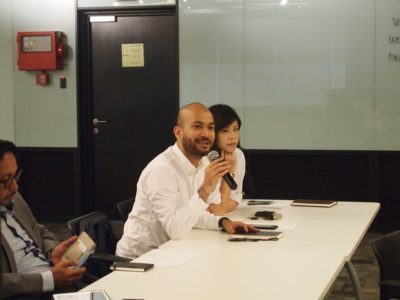
もうひとついえるのは、人材不足でしょうか。法人会員からの資金援助とは別に、移行期間の運営を支援するために、生態系(エコシステム)の一部となる人材を補完しなくてはいけないですよね。
One interesting part to add on is man-power issues. Apart from funding from corporate members perhaps we could look into supplementing man-power to be part of the ecosystem to help run the transition period.
リウ(Riuh)というプラットフォーム Riuh as a platform
アフェンディ・アリ(マイ・クリエイティブ・ベンチャーズ) Affendy Ali, My Creative Ventures
私たちは、リウ(Riuh)と呼ばれるイニシアチブに取り組んでいます。これは主に3つの点に特化したクリエイティブ・プラットフォームです。ポップアップショップ、クリエイティブワークショップ(クリエイティブ教育がここにあてはまります)、ショーケース/パフォーマンスがあります。芸術市場や芸術バザールではなく、創造的なプラットフォームと呼んでいます。マレーシアの創造経済と創造的な文化をより包括的にカバーしたいと考えています。私たちが若者の参加と活性の面において、リウが完璧なプラットフォームになると考えています。
MyCreative is working on this initiative called Riuh, it’s a creative platform that does three main things; pop up stores, creative workshops (that’s where creative education comes in) and showcases/performances. We called it a creative platform as opposed to arts market or arts bazaar, we want to be more holistic covering the creative economy and creative culture in Malaysia. When we were talking about engagement and activating youth, Riuh can be the perfect platform for that.
ブライアン(マイパ)はマイパがこの連合の事務局としてボランティアしていくことを伝え、会議は終了しました。
Brian closes the meeting with volunteering MyPAA as the secretariat and thanks everyone.
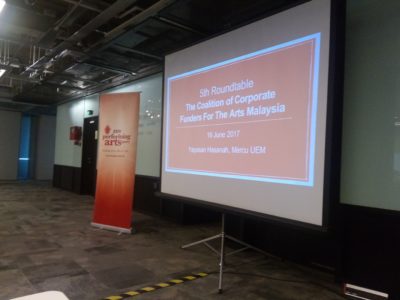
2017年6月16日 16 June 2017
ハザナ財団にて Yayasan Hasanah
